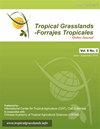Salinity tolerance of Avena sativa fodder genotypes
IF 0.7
4区 农林科学
Q3 AGRICULTURE, DAIRY & ANIMAL SCIENCE
引用次数: 2
Abstract
Oats (Avena sativa L.) is an important winter season fodder cultivated in many parts of the world. India faces huge shortages of green forage and possesses large salt-affected areas, so identification of salt-tolerant material offers scope for breeding of cultivars for increasing production from salt-affected soils. Forty-eight genotypes of oats comprised of cultivars, germplasm accessions and advanced breeding lines were evaluated with the aim of identifying salt-tolerant genotypes for use on saline soils and/or in programs to breed more salt-tolerant cultivars. Screening was carried out at different growth stages in both pot and field studies. Germination and seedling vigor at different levels of salinity in terms of electrical conductivity (EC), i.e. EC4, EC8, EC12 and EC16, were assessed. Field-level salinity tolerance was assessed in pits where soils had EC ranging from 3.3 to 3.6 dS/m and pH 9.6. Sand culture experiments were carried out on 2 genotypes at different levels of NaCl solution as well as saline soil scrap solution so as to simulate a real field situation. Na, K, Ca and proline concentrations were estimated to understand the mechanism of salinity tolerance of the crop. The study resulted in identification of some suitable genotypes with acceptable levels of salt tolerance, which can be used in developing productive cultivars for saline soils.玉米饲料基因型的耐盐性
燕麦(Avena sativa L.)是世界上许多地区重要的冬季饲料。印度面临着绿色牧草的严重短缺,并且拥有大面积的受盐影响的地区,因此鉴定耐盐材料为培育品种提供了空间,从而提高受盐影响土壤的产量。对燕麦品种、种质资源和高级选育系的48个基因型进行了评价,目的是确定耐盐基因型,以便在盐碱地和/或计划中培育更耐盐的品种。在盆栽和田间试验的不同生长阶段进行筛选。以电导率(EC) (EC4、EC8、EC12和EC16)为指标,对不同盐度条件下的发芽和幼苗活力进行了评价。在土壤EC值为3.3 ~ 3.6 dS/m, pH值为9.6的坑中,评估了现场水平的耐盐性。对2个基因型进行不同水平NaCl溶液和盐渍土废溶液的沙培试验,模拟田间真实情况。通过测定Na、K、Ca和脯氨酸的浓度来了解作物耐盐的机理。研究结果鉴定出一些耐盐性可接受的合适基因型,可用于盐碱地生产品种的培育。
本文章由计算机程序翻译,如有差异,请以英文原文为准。
求助全文
约1分钟内获得全文
求助全文
来源期刊

Tropical Grasslands-Forrajes Tropicales
Agricultural and Biological Sciences-Agronomy and Crop Science
CiteScore
1.60
自引率
0.00%
发文量
36
审稿时长
16 weeks
期刊介绍:
The Journal publishes, in English or Spanish, Research Papers and Short Communications on research and development, as well as contributions from practitioners (Farmer Contributions) and Review Articles, related to pastures and forages in the tropics and subtropics. There is no regional focus; the information published should be of interest to a wide readership, encomprising researchers, academics, students, technicians, development workers and farmers.
In general, the focus of the Journal is more on sown (''improved'') pastures and forages than on rangeland-specific aspects of natural grasslands, but exceptions are possible (e.g. when a submission is relevant for a particularly broad readership in the pasture and forage science community).
The Journal will also consider the occasional publication of associated, but closely related, research in the form of an additional scientific communication platform [e.g. a re-make of the former Genetic Resources Communication series of the former Division of Tropical Crops and Pastures of the Commonwealth Scientific and Industrial Research Organisation (CSIRO), Australia].
Areas of particular interest to the Journal are:
Forage Genetic Resources and Livestock Production[...]
Environmental Functions of Forages[...]
Socio-economic Aspects[...]
Topics within the aforementioned areas may include: Diversity evaluation; Agronomy; Establishment (including fertilization); Management and utilization; Animal production; Nutritive value; Biotic stresses (pests and diseases, weeds); Abiotic stresses (soil fertility, water, temperature); Genetics and breeding; Biogeography and germplasm collections; Seed production; Ecology; Physiology; Rhizobiology (including BNF, BNI, mycorrhizae); Forage conservation; Economics; Multilocational experimentation; Modelling.
 求助内容:
求助内容: 应助结果提醒方式:
应助结果提醒方式:


